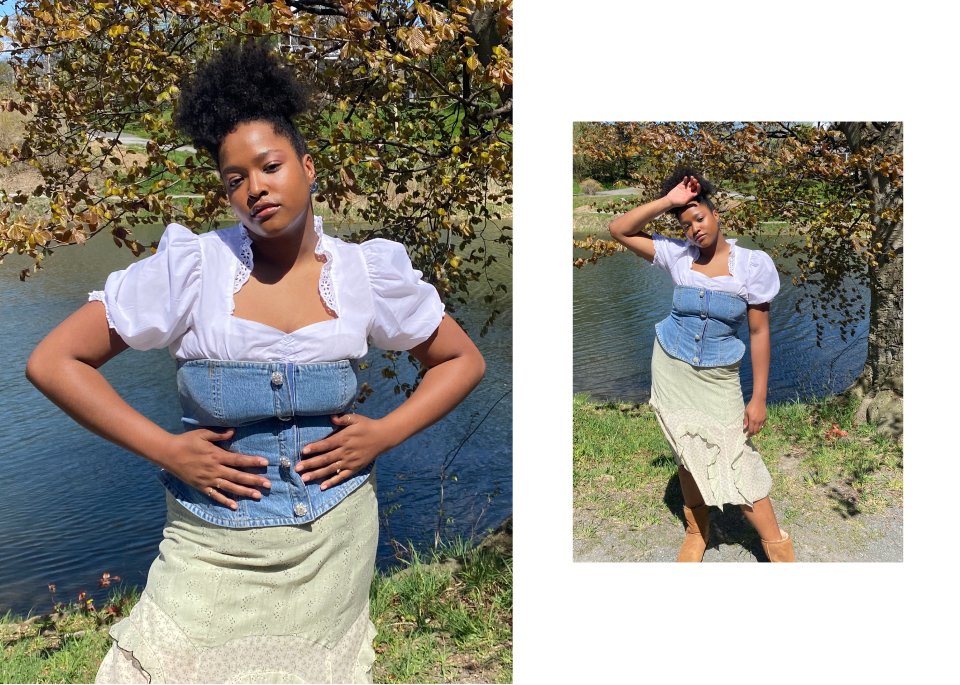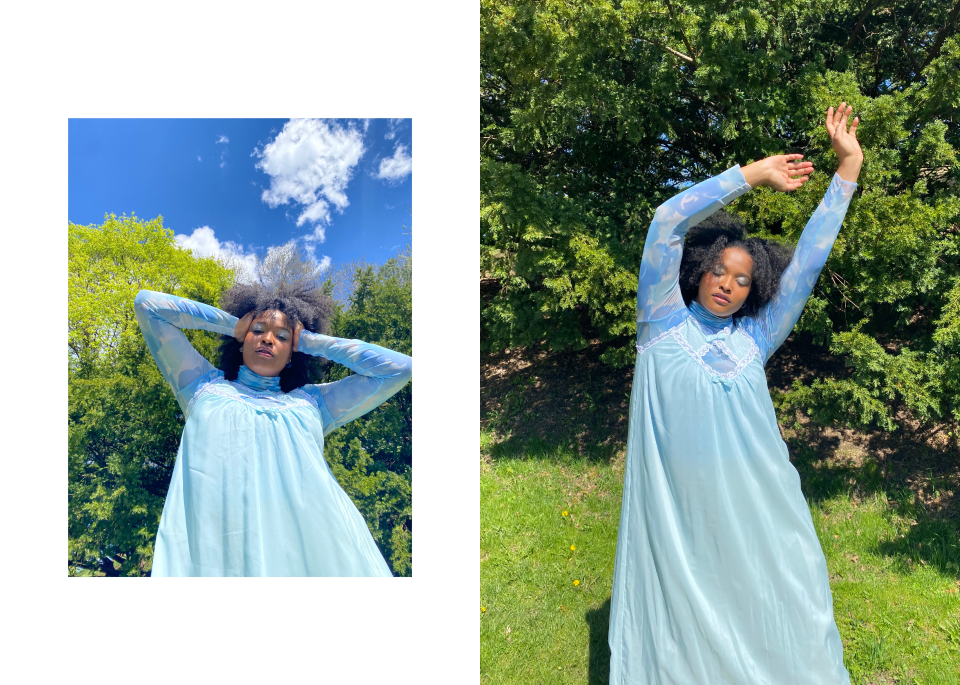Why Cottagecore and Prairie Dressing Are Fashion’s Biggest Trends in 2020
Long prairie dresses, bucolic countryside scenes with clothing lines drying in the sunlight, puffy sleeves, sunglasses, and gingham: These are just a few of the aesthetic references that relate to cottagecore, which is quickly becoming one of the biggest fashion subcultures in 2020.
If you’ve scrolled through TikTok lately, you’ve likely seen the tags #cottagecore or #farmcore along with some of this aforementioned imagery. It’s true that cottagecore is not just a fashion subculture, but an idealized lifestyle that goes hand in hand with floor-sweeping prairie dresses and quilted jackets. Knitting, crocheting, baking, and sewing are some of the activities that cottagecore content usually includes.
According to the Urban Dictionary, the exact definition of cottagecore is: “A niche aesthetic based around the visual culture of an idealized life on a Western farm. Common themes include sustainability, gardens, farm animals, rural living, and nature.” And while the word was just added in 2019, there’s been evidence of the trend spiking in popularity when many Instagram users used the tag in 2018.
With all that’s going on in the world right now, it makes sense that this calming and cozy aesthetic is blowing up not only on social media, but also in our shopping habits. According to Shopstyle, the aggregative shopping website is seeing an increase in consumers searching for products tied to the cottagecore trend, such as quilts (+400% in search volume YoY), gardening gloves (+100% in search volume YoY), clogs (+44% in search Volume YoY), and rolling pins (+200% in search volume YoY).
Similarly, fashion trend forecasters have had the idea of cottagecore on their minds for a few seasons now. “We've been tracking this idea of 'slow living' for a while now,” says Hallie Spradlin, accessories director at Fashion Snoops. “When things feel chaotic and out of control, people tend to revert back to comfort and familiarity, taking stock of the things that are important and deemed essential to their well-being. Though cottagecore started sprouting before the pandemic because of eco-anxiety and other distressing societal factors, it feels especially relevant and comforting now to dream of retreating to a cottage in an overgrown forest, perhaps with a deer or a magical fairy as a friendly neighbor.”
If you follow fashion closely, you’ve likely seen the cottagecore trend on the runways for a few years. Batsheva, an indie label known for its stylized prairie dresses, gained a lot of popularity in 2018. Perhaps coincidentally, or not, the #MeToo movement was also exploding in popularity during this time. “This dramatically changed the way women choose to present themselves vis-à-vis fashion,” says Michelle Tolini Finamore, fashion and design curator. “Being more covered up is okay…the voluminous maxi dress has been back in a big way these past few seasons. I own one by Project Runway winner and Boston-based designer Erin Robertson, and I love it.”

Likewise, for spring 2020, designers such as Puppets and Puppets, Markarian, Tory Burch, Maryam Nassir Zadeh, Jonathan Simkhai, and Kate Spade New York were particularly experimental with crafts elements associated with the movement, such as crochet, knits, and handmade prints. Gingham, too, a classic print associated with farm life and picnicking was seen at Maryam Nassir Zadeh, Christopher John Rogers, Ulla Johnson, and Sandy Liang.
Some labels are taking cottagecore to an even more extreme level, like the indie jewelry brand Beepy Bella. Designer Isabella Lalonde stringes fantasy inspired necklaces together which often consist of handcrafted frogs, fairies, mushrooms, butterflies, and fairies. She also recently created a cottagecore-esque fairytale book featuring work from her friends and fans.
And still, there’s no denying celebrities like Kendall Jenner and Gigi Hadid also love the trend. Think cowboy boots, cow prints, and loose, long dresses. The spring runways were also full of prairie dressing moments and the cottagecore aesthetic. Some of these elements are part of the yeehaw agenda, which was popularized by Lil Nas in the summer of 2019. In some ways, cottagecore is developing as a less racially diverse version of that movement.
However, the cottagecore aesthetic has long had a place in fashion, according to historiansr. “A desire to escape to a simpler, more bucolic life is nothing new. 18th-century fashion icon Marie Antoinette had an entire rustic village (the Hameau de la Reine) built for her and her friends to play at, as an idyllic version of peasant life,” explains Allison Pfingst, fashion historian and advisor at the Fashion Studies program at Fordham University. There, the French queen often wore summery, simplified clothing, such as sun hats, draped muslin dresses, and peasant-inspired dresses. “Her peasant-inspired dress, sometimes called the chemise à la reine, caused quite a stir — especially when she had artist Elisabeth Vigée Le Brun painted her in such attire in 1783. The image was heavily criticized, with many believing she looked like she was wearing nothing but undergarments — but nonetheless the look caught on.”

Pfingst also links the trend back to some of the aesthetic movements occuring during the mid-19th century, including the Dress Reform (“Often middle-class women active in first-wave feminism and other social causes, wanted clothing that was more practical, comfortable, and modest,” she says), the Arts and Crafts (“simple, rustic, handmade, and based on the flora and fauna of the British countryside”), Artistic Dress (“A byproduct of the work of the Pre-Raphaelite Brotherhood, a group of artists who were interested in emulating the work of the Old Masters.… They dressed their models in robes and gowns that were inspired by the Middle Ages”), and Aesthetic Dress movements. The Aesthetic Dress movement of the 1880s and 1890s “was a continuation of the styles of the above movements — without the social agendas or moral ideals. Aestheticism was about beauty for the sake of beauty,” adds Pfingst.
Elsewhere, other historians link the prairie dressing and the cottagecore trend to more modern times. “The most direct lineage to the cottagecore aesthetic was the emergence of a fashion for long, floral, ruffled dresses reminiscent of Little House on the Prairie in the 1960s and 70s,” explains Elena Kanagy-Loux, fashion historian and collections specialist at the Antonio Ratti Textile Center, Metropolitan Museum of Art.
According to Kanagy-Loux: “Two brands in particular epitomized this style: Laura Ashley, which was founded by its Welsh namesake in 1953, and Gunne Sax, which was cofounded by two seamstresses in San Francisco in 1967 before designer Jessica McClintock took the helm. Although the two brands stemmed from distinct backgrounds, their mash-up of Victorian calico-print cottons and DIY hippie fashion captured the zeitgeist for idealized nostalgia peppered in pretty floral prints. Along with labels such as Young Edwardian [by Arpeja] and Holly Hobbie, they were embraced by bridesmaids and counterculture homesteaders alike.”
Regardless of its history, cottagecore has become one of the most popular new subcultures since it offers a digital community. In particular, the queer community is flocking to the aesthetic as a safe and comforting form of escape. “Queer teens have found solace in the cottagecore movement online because it's a safe space to express tenderness, connection, and unapolegetic yearning when they might not feel safe to do that in other places in their lives,” explains Spradlin. “Much like what cottagecore itself encourages, it's a world in which they can foster and nurture not only pieces of the earth in plants and crafts and baking, but also with each other in this idyllic aesthetic.”

Other fans of cottagecore and prairie dressing have simply grown up with similar values and are now finding they have more of a community than ever before. Chloe Barcelou, a stylist and production designer who lives in a tiny house and identifies with the aesthetic, grew up wearing Laura Ashley, GunneSax, Selkie, Liberty London, and other vintage prairie dresses, but just joined TikTok in April 2020 to find a vibrant community with similar aesthetic to her own. “In many ways I grew up in a very stylistic environment — my mom is very stylish — so my lifestyle from childhood was very cottagecore,” she explains. “My mom cooked from scratch, took me along to the farmers market, we always shopped at thrift stores, and she dressed me up in Liberty London dresses that my grandmother would make, including smocking. I would say the lifestyle really blew up for me in 2014 when I began building my tiny home with my fiancé.”
She adds: “'I’m not even sure I'm choosing it so much, as it just heavily involves all the things I love, and the way of life I enjoy. I really love that the trends recently seem to be going back to an old-fashioned way of life, where living slowly and intentionally are becoming priorities, spending time in nature and making things from scratch are now valuable again.”
Along with that, model Imani Randolph has been exploring the idea of cottagecore since she moved back in with her parents in Albany, New York. “From my childhood through my teen years, I frequented the seasonal county fairs to marvel at livestock competitions and ride carnival rides of course, and I annually went apple picking with my family at nearby orchards,” she explains. "The school that I attended from kindergarten through 8th grade is built on 77 acres of land, so nature walks were plentiful — even one of my classmates. This is all to say that elements of cottagecore were more or less ingrained in my upbringing and quarantine has given me the opportunity to reacquaint myself with them.”
She adds, “During my time in quarantine, I've been gravitating towards comfort and simple pleasures. Bonus points for anything that doesn't require me to wear a bra. Most days, it's still been quite chilly here, so for my time outside I've been swaddling myself in knits, flowy floral dresses and I just adore the square neckline and I'm a sucker for a puffed sleeve.”
If anything, cottagecore and prairie dressing will only continue to gain popularity. It’s a natural progression given everything going on in the world. “If you look at our historical comparisons, it’s easy to see the similarities,” says Pfingst. “The court of Versailles before the French Revolution is the quintessential example of an excess of luxury and indulgence in the context of gross inequality.… We are constantly bombarded by images of influencers, models, celebrities, and an exponentially growing number of Kardashians in our feeds. Seeing them all decked out in unattainable designer clothing at swanky parties or on dream vacations gives off strong ‘Let them eat cake’ vibes.”

Likewise, as a huge part of the world is on lockdown because of COVID-19, cottagecore is an easy escape from the tiny apartments or cities we’re living in. We can’t travel right now, but simply looking at a cottagecore lifestyle on TikTok puts you in another mindset. “Many people are stuck in small apartments without access to private outdoor spaces, and cottagecore aesthetics provide a soothing escape: Even if you aren’t able to run through a field of flowers in a flowing pinafore, at least you can dress like it in your bedroom, and even add some mushroom or wildflower stickers to your selfies,” says Kanagy-Loux. “Critics might point out that the kind of floral prairie dresses popularized by the cottagecore aesthetic are incompatible with actual farm labor. However, I don’t think the end goal of cottagecore is necessarily to escape modern living, but rather to find solace in nature’s beauty, and there are many benefits in aspiring to a more whole-grain lifestyle even if you never live in a cottage of your own.”
With that said, cottagecore seems to be the answer to finding even a small slice of happiness and comfort in fashion for our modern times.
Originally Appeared on Teen Vogue

